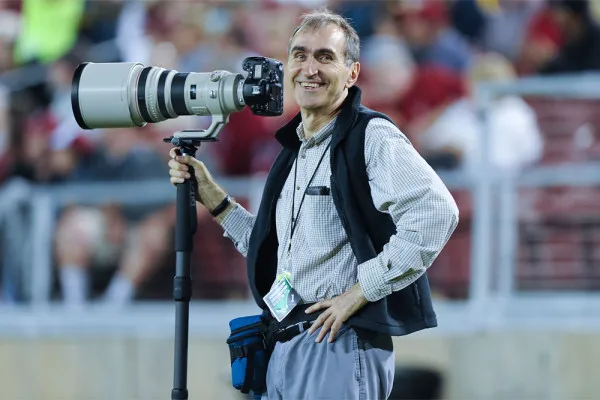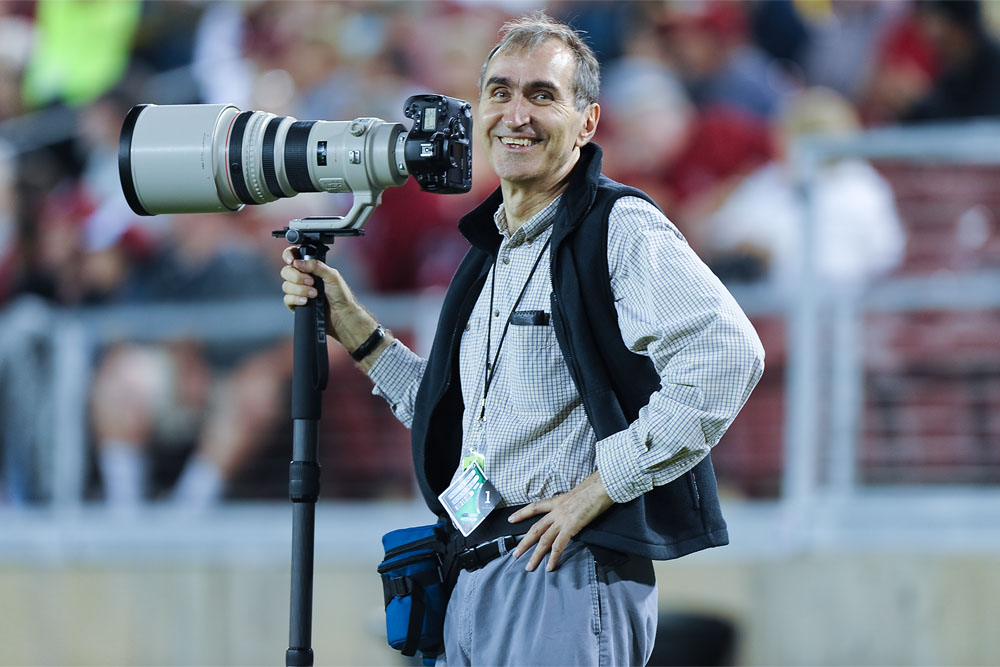Over the last 22 years, Hector Garcia-Molina M.S. ‘75 M.S. ‘77 Ph.D. ‘79 has slowly but surely carved his niche into Stanford’s computer science department.
Perhaps best known as the former research advisor to Google co-founder Sergey Brin, Garcia-Molina has become one of the premier names in the fields of digital computation and information technology. He was the principal investigator for the Stanford Digital Library Project in the late 1990s, which was a driving factor behind the eventual development of the Google search engine.
That’s the side that most people see, anyway.

Garcia-Molina’s extensive work in computer science only tells half the story. Yes, Garcia-Molina’s academic reputation precedes him, but his identity is just as much governed by something that started as a casual hobby but has quickly transformed into a passion that rivals his love for computer science: photography.
When talking about photography, Garcia-Molina’s eyes light up and a wide grin spreads across his face, leaving little doubt about his love for the art.
“I don’t normally do interviews, but I love to talk about photography,” he said earnestly.
Garcia-Molina gets just as excited talking about his vast collection of lenses, of which he “definitely has too many,” as he does talking about his life’s work; he spends his free time capturing the essence of humanity as he sees it and, for hours on end, lovingly arranging those snapshots into slideshows that he carefully pairs with “just the right music” to showcase to the fullest effect.
Hector Garcia-Molina is a computer scientist. But equally so, Hector Garcia-Molina is a photographer.
***
On any given weekend during the Stanford sports season, it’s a safe bet that you’ll see Garcia-Molina on the sidelines snapping photos of the action for Stanford Athletics. Looking at how he carries himself and the quality of his work, it’s nearly impossible to tell that he has no formal training in the art.
He takes after his father, who was also a college professor in Mexico who took on photography as a serious hobby on the side. Over the years, the elder Garcia-Molina took thousands of photos and even purchased his son a camera to capture his interest.
Though the camera certainly helped Garcia-Molina get early exposure to photography, his father’s more significant contribution to his photography career was more indirect, initially manifesting as a startling discovery on a trip home 20 years ago.
“My mother said, ‘I’m cleaning this closet, and I’m going to throw away all of the slides that your father has. They’re just gathering dust and we haven’t seen them in years,’” Garcia-Molina recounted. “‘The projector broke, and we just don’t want them here.’ This is literally a closet full of 35-millimeter transparencies. I just said, ‘Wait a minute, wait a minute; you can’t just throw these out! Give me a second, let me have a few of them!’”
After his mother promised that she wouldn’t throw any of the shots out, Garcia-Molina’s technology-focused mind kicked into gear and drove him to search both books and the web for ways in which he could restore those transparencies — often dusty, scratched and at times moldy — and preserve those memories.
Although it was a completely unfamiliar area and the learning curve was steep, months of hard work from Garcia-Molina proved fruitful; he was able to not only resurrect decades of family memories that he was able to share, but also gain valuable firsthand experience working with photos that only furthered his interest and gave him better technical ability in the field.
“I discovered it was lots of fun. These pictures that I wouldn’t remember would come to life,” he said. “The effect was great, because I could improve the lighting and cropping. My father was very passionate but he wasn’t very good at framing and getting the light right. In Photoshop, I could fix a lot of that, and I started building up a collection of family photos in much better shape.”
As he developed his eye for photography and resurrected his father’s work, he started out with his first SLR camera just as many amateur photographers have: by messing around with his camera to document the growth of his child.
“I took pictures of [my son] and family pictures and so on, just like any father would take,” he said. “But only when he went off to college and I had more time, I started taking pictures of other things.”
And as incidentally as his photography career had started, Garcia-Molina’s sports photography career began in just as impromptu of a manner. One day, he bought a new lens and was itching to try it out, but his son wasn’t around to be his subject and he decided to go take a walk around Stanford to find something new to document.
“For some reason, I went around the athletic fields to find something to photograph and there were some soccer players practicing,” he said. “I just stood there and took some pictures, and I enjoyed it. It was a challenge to get things in focus and get the right moment.”
That initial foray into sports photography piqued his interest, and on his next outing, he was in the stands of a Stanford athletic matchup taking photos from the stands. It eventually became a regular pastime of his, and when the other volunteer photographers at StanfordPhoto.com noticed him and invited him to join them several years later, he eagerly accepted the opportunity.
Not only would Garcia-Molina have the chance to showcase his work on a larger stage under the banner of Stanford Athletics, but he would also be able to go to whatever events he wanted and take photos whenever he wanted, giving him a formal outlet for his passion. He has since firmly established himself as one of the most talented sports photographers on that staff.
***
Today, Garcia-Molina continues to shoot photos for Stanford Athletics but has also managed to bring together the two fields that he is most passionate about — academics and photography — in the form of the freshman seminar that he teaches: “Computers and Photography: From Capture to Sharing.”
“I just enjoy showing people how to do things, whether it’s writing programs, writing algorithms or taking photos,” he said. “I get a kick when I see my students be successful, whether it’s at computer science or business or taking good photos.”
He also likes to provide a hands-on way for his students to improve, and with that mission in mind, he often invites groups of his current and former students to follow him to his sports shoots to give them a firsthand taste of his style and techniques. Through those excursions, he has developed close relationships with many of his students, several of whom have become “regulars” as they have developed as photographers following in his footsteps.
That isn’t to say that he has stopped developing as a photographer himself. One of the unique things that Garcia-Molina likes to do is to take one camera and one lens to the events that he photographs, and to vary the angles, positions and settings from which he shoots instead of other settings or configurations.
While the lack of equipment means that he won’t necessarily get all of the shots that other photographers would, he likes the unique perspective it gives him on some of the close-range shots out of the conventional range of his lens. For somebody with a scientific mind like Garcia-Molina’s, the process of experimentation and discovery is just as fascinating as the finished product.
That perspective has also translated to Garcia-Molina’s photography, for which he not only continues to develop his skill and technical ability, but also has begun to establish an artistic vision that he chooses to stick by and convey through his photos. Much of that lies in the kinds of shots that he likes to take: He only likes to take shots that capture the human element of scenes, showing his subjects’ expressions in moments of stress or exertion.
“If I don’t see the face, I don’t take the picture,” he said. “It could be just a wax figure for all I know if I can’t see the face. It just doesn’t excite me or interest me as much.”
Because of that, his favorite events to shoot are sports like rugby, water polo and synchronized swimming, where the exertion of all of the athletes is evident and there is relatively little covering their faces. In contrast, he admits that repetitive sports like baseball in which caps or helmets obscure faces and expressions are of less interest to him.
In the slideshows of photos that he compiles after each year of sports, there are variety of grimaces, contortions and scowls on the faces of the athletes. But what is constant through all of the photos is the careful framing, lighting and timing that brings the subject to life and fully conveys the emotion of the shot.
It’s a care that stems from the passion that started a generation earlier with the elder Garcia-Molina, but manifested itself relatively late in life for Hector after his father’s work inspired his fire for the subject. Will Garcia-Molina’s son — the subject of his father’s first serious photos — follow in those footsteps as well?
“He’s not interested,” Garcia-Molina says with a laugh. “I’ve tried to get him interested, but he just doesn’t like it as much.”
Contact Do-Hyoung Park at dpark027 ‘at’ stanford ‘dot’ edu.
